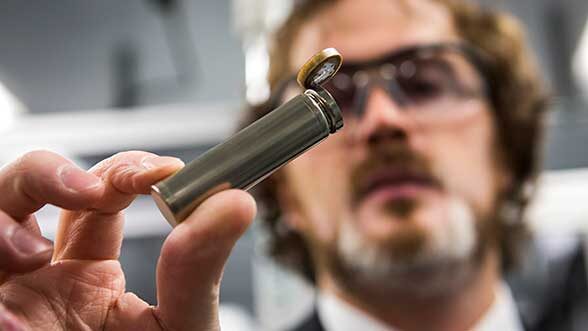Power up

Greg Less displays a battery produced at the U-M Energy Institute. See photos from the Battery Lab’s opening.
They power your electric vehicle so you can bypass gas stations on your way up north.
They power pacemakers so patients can overcome abnormal heart rhythms and live comfortably.
And they power your cellphone so you can stay connected during lengthy conference calls.
They’re batteries and they power many of the devices we use on a daily basis. But as technology in vehicles, medical implants, and cell phones continues to evolve, battery technology also must follow suit.
Enter the Battery Fabrication and Characterization User Facility, a new 2,700-square foot lab housed on U-M’s North Campus. The lab, funded by U-M, Ford Motor Co. and the Michigan Economic Development Corp., provides space and tools for researchers to find ways to make batteries lighter, safer and less costly.
“We feel confident that we’ve built the nation’s most complete, customized battery research facility,” says Mark Barteau, director of the U-M Energy Institute. “The technology available here will help researchers develop batteries that are capable of powering devices of the future, further expanding the Midwest’s rapidly growing battery research and manufacturing capabilities.”
“Innovation is our goal”
Automotive researchers worldwide are tasked with a similar assignment: Develop an automotive battery that can match the energy output of liquid fuel.The creation of such batteries could transform the future of transportation, eliminating our reliance on fuel, but it’s certainly no easy task.
For starters, many manufacturers lack bandwidth in their facilities to test new ideas because their production lines are busy making current production cells.
“A majority of people who are testing out these batteries are often doing so on a small, laboratory scale,” says Greg Less, manager of the Battery Lab. “But small scale isn’t sufficient to gather the data necessary to convince potential customers of a new battery product. Our lab allows people to test their next-generation ideas on a larger, more production-level scale, which allows for more accurate testing of things like cycle life and abuse tolerance.”
Lab users can build and characterize multiple types of batteries, including coin cells, 18650s, and prismatic pouch cells. Coin cells often are similar to the batteries found in your wristwatch, while 18650 batteries are used in electric vehicles and power tools. Prismatic pouch cells also are used in electric vehicles, as well as laptop computers.
The investment in infrastructure throughout the lab will help spark breakthroughs to make both electric vehicles and grid storage viable at all scales needed for the future.
“Innovation is our goal,” says Ted Miller, senior manager of energy storage strategy and research at Ford. “We have a vision of accelerating vehicle battery technology and making Michigan the battery capital of the country, and the Battery Lab helps us reach our goal.”
Charged and ready
The lab is designed to meet an industry-wide need for pilot-scale battery fabrication, characterization and testing for grid storage, transportation, and consumer products. The facility will provide critical infrastructure for the characterization, scale-up, and testing of existing and next-generation energy storage materials and devices.
The lab also distinguishes itself from other battery facilities worldwide because of its unique access policy. The open-access lab provides space to build and test battery concepts, while fully protecting the intellectual property (IP) of its users.“We don’t want to own part of the intellectual property of our customers,” Less says. “We are set up to completely avoid IP entanglement, if at all possible.”
The ability for users to fully protect their intellectual property has attracted global interest from startups, large corporations, and scholars to the lab, which already is booked into early next year.
“We’re giving people the ability to make batteries better and faster than they would be able to do otherwise,” Less says. “That’s really the key. It would be really awesome if some company were to develop a next-generation battery, and their initial work was done here at the Battery Lab. That would be a dream come true.”
This story is reprinted courtesy of Michigan Research.




Eric Carlson - 1985
Excellent, and much needed research!
Reply
Kevin Luoma - 1999
Great news, developing effective batteries to harness the suns energy is a game changer for our planet and it is awesome to see our university cares about it.
Reply
James Hemsath - 1975
In a small corner of GG Brown I spent my last semester building and testing fuel cells. Not quite batteries, but not dissimilar. Very excited to see this lab and pretend that I played in the field for a tiny bit
Reply